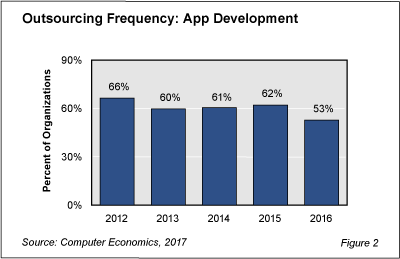While application development remains one of the more popular IT functions to outsource, our research indicates growth in this form of outsourcing has shown little change over the past five years, until dropping this year.
As shown in Figure 2 from our study, Application Development Outsourcing Trends and Customer Experience, about 53% of IT organizations outsourced application development work in 2016, which is a noticeable drop from the 66% rate in 2012.

Sluggish growth in capital investment, growing use of software-as-a-service (SaaS), and increased internal hiring by IT organizations may all be factoring into this trend. But the study also finds that IT organizations are having limited success in lowering costs or improving service levels through outsourcing application development to service providers.
“We’ve seen most of the outsourcing areas that we observe shrinking a bit this year,” said David Wagner, vice president for research at Irvine, Calif.-based Computer Economics. “It appears that companies may be bringing a lot of functions back in-house as the economy improves. But there is no doubt that SaaS also will have a long-term impact on app dev outsourcing as organizations shy away from custom apps for the more flexible and efficient SaaS apps.”
In light of current challenges, the full study is designed to help IT executives compare their outsourcing activity and experience with other IT organizations. The study uses three metrics to measure application development outsourcing activity: it determines how many organizations outsource application development (frequency), how much of the workload is typically outsourced (level), and the change in the amount of work being outsourced (trend). We also measure the cost experience and service experience of companies that outsource this function, and determine how outsourcing activity and experience vary by organization size and sector.
In this study, the term “outsourcing” is distinct from the term “offshoring.” In fact, we find most outsourcing involves domestic service providers. As such, a company can be outsourcing work but not offshoring work. Conversely, a company with global operations could move work offshore without outsourcing it. Of course, in the case of application development, global labor arbitrage is prevalent. Service providers in India, Russia, and Eastern Europe aggressively market their services to U.S. companies, and today even small IT organizations are gaining access to offshore service providers.
We also treat application maintenance outsourcing as a separate category. Maintenance is an ongoing, operational function, whereas development is a project-based activity. Application development and maintenance outsourcing taken together is called application management outsourcing and thus is included in both categories.
This Research Byte is based on our report on this subject, Application Development Outsourcing Trends and Customer Experience. The full report is available at no charge for Computer Economics clients, or it may be purchased by non-clients directly from our website (click for pricing).

